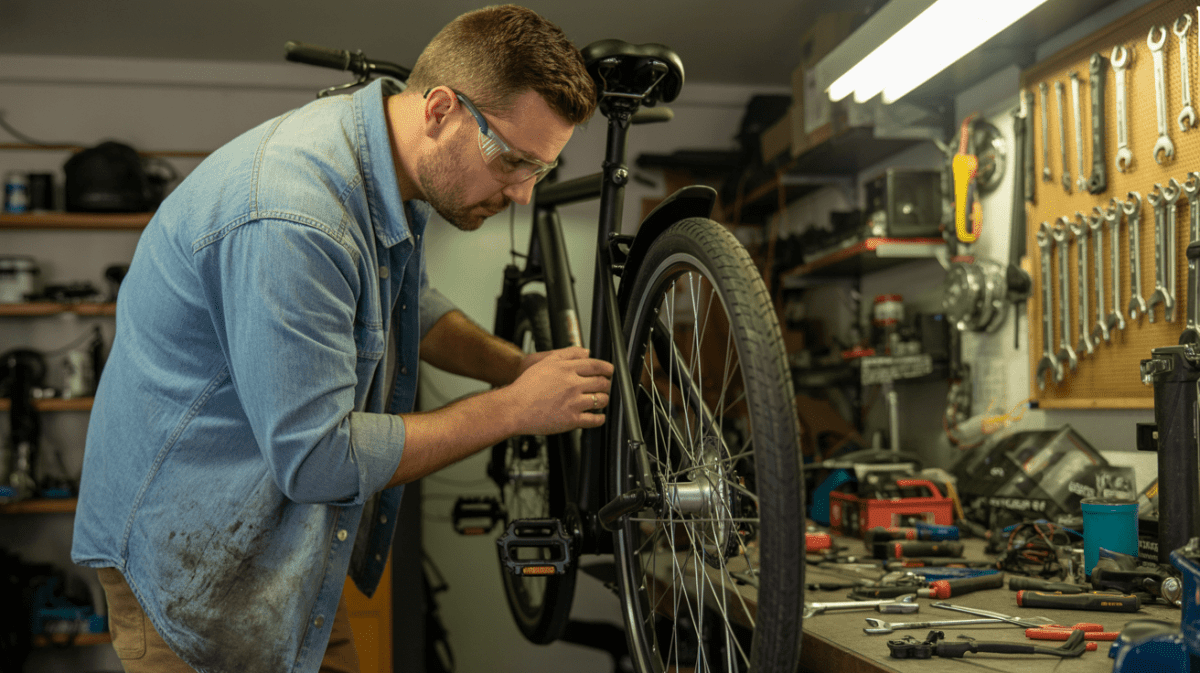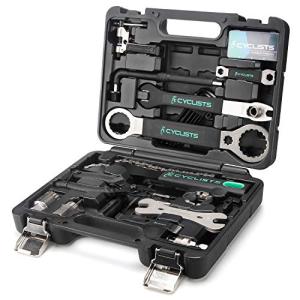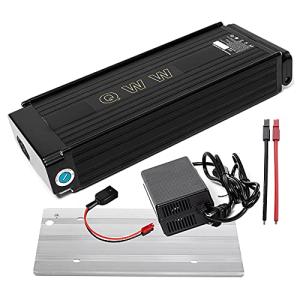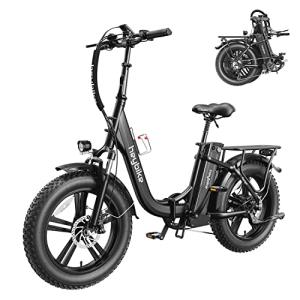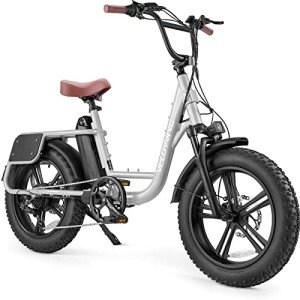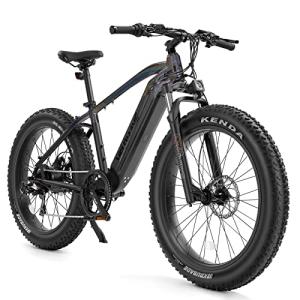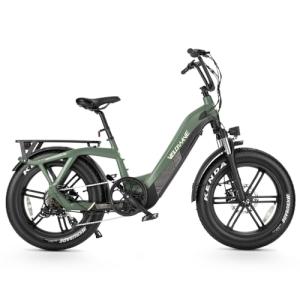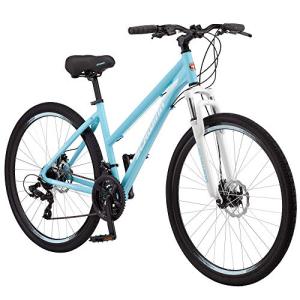A Maintenance Schedule Guide:
Keeping your e-bike in top shape takes more than just charging the battery and heading out for a spin. Regular maintenance extends the bike’s life and keeps every ride safe and smooth.
Most e-bikes require a monthly check and a full professional service about once a year, though mileage and terrain can change that schedule.
Basic upkeep like checking tire pressure, cleaning the chain, and inspecting brakes should become part of your routine. Parts wear down faster with frequent use or rough conditions, so it’s good to know when you can handle small tasks at home and when it’s time for a pro tune-up.
Key Takeaways
- E-bikes need routine checks and yearly professional servicing.
- Small tasks at home prevent bigger problems later.
- Riding style and conditions affect how often service is needed.
How Often Should You Service Your E-Bike?
Your e-bike needs regular care to stay safe, efficient, and reliable. How often you should service it depends on how much you ride, the terrain, and total mileage.
There are some basic schedules most riders can follow to keep their e-bike in good shape.
Recommended Service Intervals
Most people do well with a basic check every month and a professional service once a year. A monthly check covers tire pressure, brake pad wear, and chain lubrication.
These quick tasks prevent small problems from escalating into costly repairs. A yearly service usually means a full inspection at a bike shop.
Mechanics check wheel alignment, swap out worn parts, and update firmware if your bike uses electronics. This keeps your e-bike safe and running well for the long haul.
Some folks need more frequent servicing. For example, mountain e-bikes on rough trails often need brake and suspension checks every few months.
If you commute daily, you may go through chains and brake pads more quickly, requiring more frequent attention.
Quick guide:
- Weekly: Clean, inspect chain, check brakes, inflate tires
- Monthly: Gear adjustments, suspension check, battery inspection
- Yearly: Full tune-up, cable replacement, firmware updates
Mileage-Based Maintenance
Tracking your mileage is a solid way to plan an e-bike maintenance schedule. Many shops suggest a basic check every 200–300 miles and a professional service every 1,000–1,500 miles.
This lets you keep tabs on chains, brake pads, and tires, which all wear out with use. Chains last about 1,000 miles before they stretch too much.
Brake pads might go 500–700 miles, depending on where and how you ride. Tires can last 2,000–3,000 miles, but rough roads will shorten that.
If you track your rides or use the bike’s display to log distance, a mileage-based schedule makes it easy to know when things need attention.
Time-Based Maintenance
Even if your e-bike sits unused, parts still age. Rubber tires and brake pads can dry out, and batteries lose capacity over time.
That’s why a time-based service schedule matters too. Aim for a basic service every 3 months, a mid-level service every 6 months, and a full professional service every 12 months.
This keeps your bike ready to ride, even if you’re not logging big miles. For example:
- 3 months: Clean, lubricate, check bolts, test brakes
- 6 months: Inspect suspension, gears, and electronics
- 12 months: Replace cables, overhaul drivetrain, test battery health
Key Components That Require Regular Maintenance
Your e-bike stays safe and efficient when its most-used parts get regular attention. The battery, brakes, and tires each play a big role in how your bike feels and lasts.
23-Piece Bike Tool Kit for Easy Repairs
Everything you need for quick and hassle-free bike fixes on the go
Product information
$78.98
Product Review Score
4.24 out of 5 stars
188 reviewsProduct links
Battery Health and Care
The battery’s the priciest single part of your e-bike. Taking care of it helps extend its lifespan and saves you money down the road.
Try not to run the battery down—deep discharges shorten its life. Charge it after most rides, keeping it between 20% and 80% when you can.
Store your battery in a cool, dry spot to avoid overheating or freezing. Both extremes can hurt battery health.
Wipe the battery contacts with a dry cloth to keep the connection solid. If you’re not riding for weeks, leave the battery at about 50% charge and check it monthly.
Brake Function and Adjustment
Brakes keep you safe, so check them a lot. Both mechanical and hydraulic systems need regular looks for pad wear, rotor condition, and cable or fluid issues.
If your pads are worn, swap them out before they hit the metal backing. Brake levers should feel solid, not mushy.
If the lever feels soft or loose, adjust the system or bleed the fluid for hydraulics. Misaligned calipers can cause rubbing, which wastes energy and wears things out.
Check pad thickness, look for frayed cables, and clean rotors with isopropyl alcohol. These habits make braking smoother and more predictable.
Tire Pressure and Condition
Tires affect how your bike handles, how comfy it feels, and how much energy you use. Low pressure makes pedaling harder and ups your chance of flats.
Overinflated tires lose grip and ride harshly. Check pressure at least once a week with a good gauge.
Look for the recommended pressure range on the tire’s sidewall. Stick to it for best traction and even wear.
If you’re heavier or hauling cargo, bump the pressure up a bit for stability. Check tread depth and look for cuts, cracks, or anything stuck in the tire.
Swap out worn or damaged tires before they blow out. Clean tires make it easier to spot early signs of trouble.
Essential Maintenance Tasks for E-Bike Longevity
Keeping your e-bike in good shape means paying attention to moving parts, wheels, and electronics. Regular care here stops early wear and keeps you safer.
Chain Lubrication and Replacement
The chain moves power from you and the motor to the wheels. It needs steady care.
A clean and well-lubricated chain reduces friction, prevents rust, and extends the life of your drivetrain. Add chain lube every 100–150 miles, or after wet or dusty rides.
Clean the chain with a soft brush and mild degreaser before you lube it. Apply a thin, even layer of lube, then wipe off any excess to prevent it from picking up dirt.
Chains stretch and wear out eventually. Most last 1,000–2,000 miles, depending on your riding and the terrain.
Use a simple gauge to check stretch and know when to replace it. Changing the chain before it’s too worn saves your cassette and chainrings from damage.
Wheel Alignment and Truing
Wheels that are out of line mess with handling, braking, and tire life. Good wheel alignment keeps the rim centered between the brake pads and frame.
If you notice a side-to-side wobble, it’s time for wheel truing. Adjust spoke tension with a spoke wrench to bring the rim back in line.
It takes patience, but small fixes can be done at home with the right tool. If wobbles or loose spokes stick around, let a pro handle it.
Keeping wheels true boosts ride quality and puts less stress on your frame and fork. Check every few months or after a big hit.
Firmware Updates and Electrical Checks
Modern e-bikes rely on electronics for motor control, battery management, and displays. Brands release firmware updates to improve things or fix bugs.
Check for updates every few months using the brand’s app or at a service center. Electrical checks matter, too.
Loose connections at the motor, battery, or display can cause power loss or weird error codes. Look over cables and connectors for wear, moisture, or corrosion.
Here’s a quick list:
- Check battery contacts for dirt or corrosion
- Inspect wiring harness for pinches or frayed spots
- Test display and controls to make sure they respond right
Factors That Influence Service Frequency
The time between e-bike services depends on how and where you ride, how often you use your bike, and how you store it.
These factors affect wear on your drivetrain, brakes, tires, and battery, so your maintenance needs can vary significantly from rider to rider.
Riding Conditions and Terrain
Riding on smooth pavement puts less strain on an e-bike than rough trails or steep climbs. Dirt, gravel, and mud wear down the drivetrain faster, so chains and cassettes need cleaning and replacement sooner.
If you stick to mountain paths or technical trails, get ready to check suspension seals and brake pads more often. Salted winter roads or living near the coast? That salty air can corrode bolts, spokes, and electrical contacts faster than you'd think.
Regular cleaning and protective lubrication help, but they can’t totally prevent earlier service. Here’s a quick comparison to make things clearer:
| Terrain Type | Service Impact | Key Components Affected |
|---|---|---|
| Paved Roads | Lower wear | Tires, chain lubrication |
| Gravel/Trails | Moderate to high wear | Drivetrain, suspension |
| Muddy/Technical | High wear | Brakes, bearings, seals |
| Coastal/Salty Air | Accelerated corrosion | Electrical contacts, frame |
Frequency of Use
How often you ride shapes your service schedule. If you’re commuting daily and racking up miles, you’ll need tune-ups far more often than the weekend cruiser.
High-mileage folks should aim for at least two professional checkups each year. If you ride less, maybe once a year is fine.
Tracking your mileage—using an app or your bike’s onboard computer—makes it easier to set realistic intervals. Many guides suggest an inspection every 500–1,000 miles.
Even short daily rides add up quickly. If you use your e-bike five days a week, you’ll hit those service thresholds way faster than someone who rides just for fun.
Weather and Storage
Rain, snow, or extreme heat beat up your e-bike’s parts. Wet rides wash away lubricants and invite rust, while freezing temps sap your battery’s efficiency.
If you ride in these conditions, clean and dry your bike after every trip. Plan for more frequent inspections.
Where you store your bike matters, too, keeping it in a dry, temperature-controlled space helps your battery last longer and reduces corrosion risk.
Storing a bike outdoors—even under a cover—means more moisture and temperature swings, so you’ll need more frequent servicing.
For battery care, store it at a partial charge in a cool spot. Check electrical connections monthly to keep dirt and corrosion from causing performance issues.
Common Maintenance Mistakes to Avoid
It’s surprisingly easy to shorten your e-bike’s life by skipping simple checks. Forgetting battery care, riding with low tire pressure, or ignoring brake wear can lead to expensive repairs and less-safe rides.
Neglecting Battery Health Checks
The battery is the priciest part of an e-bike, and careless habits cut its lifespan. People often forget to charge it regularly or let it run down all the way, which stresses the cells.
Storing the battery in really hot or cold spots also causes long-term damage. A good battery health check involves monitoring charge levels, cleaning contacts, and charging before the battery gets too low.
Most makers recommend keeping the battery between 20%–80% if you can. If you notice swelling, weird heat, or a sudden drop in range, those are early warning signs.
Wipe the terminals with a dry cloth and keep water away—nobody wants a bad connection. For long-term storage, keep the battery about half charged in a cool, dry place.
Ignoring Tire Pressure
Low tire pressure is a classic mistake. Underinflated tires make the motor work harder, drain the battery, and up your chances of getting a flat.
Too much air isn’t great either—overinflated tires kill traction and comfort. Check your pressure daily or weekly, depending on how much you ride.
A floor pump with a gauge makes this quick. The right pressure is usually written on the tire’s sidewall. Go higher for pavement, lower for rough trails.
Proper tire pressure boosts efficiency and extends tire life. Skip this, and you’ll end up with uneven wear and more replacements.
Pro Bike Tool Floor Pump with Pressure Gauge
Get accurate inflation and quick, effortless pumping for all your cycling needs
Product information
$65.56
Product Review Score
4.97 out of 5 stars
160 reviewsProduct links
Overlooking Brake Performance
Brakes matter—a lot. Too many people wait until they feel uncomfortable stopping before checking their brakes, which risks accidents and damages rotors or rims.
Check pad thickness, listen for squeals, and make sure the levers feel right. Hydraulic systems might need fluid checks, while mechanical ones need cable tweaks.
Signs of trouble include longer stops, spongy levers, or uneven pad contact. Wet or hilly rides wear pads faster, so inspect more often if that sounds like you.
Good brakes mean safer rides, plain and simple.
When to Seek Professional E-Bike Servicing
Sometimes, DIY won’t cut it. When problems go beyond basic cleaning, lubrication, or tire checks, it’s time for a pro. You’ll want to spot the signs, know what to look for in a qualified technician, and have a sense of what servicing might cost.
Signs Your E-Bike Needs Immediate Service
Some issues just can’t wait. Unusual noises from the motor—like grinding or clicking—often mean internal wear.
If your battery range drops or it won’t charge easily, you might have a failing battery or a connection problem. Braking issues are another big red flag.
Hydraulic brakes that feel spongy or mechanical brakes that don’t stop smoothly need a pro’s touch. Loose or skipping chains that keep acting up after lubrication point to drivetrain wear.
Electrical problems—flickering displays, unresponsive pedal assist, sudden power loss—aren’t safe to mess with on your own. When performance changes suddenly or safety feels off, get a technician to check it out.
Choosing a Qualified Technician
Not every bike shop can handle e-bikes. A qualified tech needs specific training in e-bike systems—motors, batteries, controllers, the works.
Many brands certify certain shops or mechanics, so ask about their experience with your model. Shops that handle firmware updates, battery diagnostics, and motor servicing are a safer bet than general repair shops.
Look for clear service policies. A good shop gives you a written estimate, explains the work, and uses manufacturer-approved parts if something needs replacing.
This helps avoid warranty headaches or compatibility problems down the road.
Cost Expectations for Professional Maintenance
Professional e-bike servicing prices can vary significantly. A basic tune-up—adjustments, chain lube, brake checks—usually runs $75 to $120.
Add wheel truing or drivetrain cleaning, and the price goes up. More complex stuff—like hydraulic brake fluid replacement or suspension servicing—can cost $50 to $100 per part.
Battery diagnostics or firmware updates sometimes come with a tune-up, but a new battery is pricey—think $400 to $900. Motor repairs? Those are usually the most expensive, and sometimes replacement is the only fix, which can run $500 or more.
Shops may charge hourly, too, often $60 to $100 per hour. Knowing these numbers helps you plan and avoid nasty surprises. Staying on top of routine service usually keeps the big costs at bay.
Frequently Asked Questions
E-bikes need regular care to stay safe and reliable. How often it happens depends on factors like mileage, battery use, riding conditions, and the motor system you have.
What is the recommended frequency for a general e-bike maintenance check-up?
Do a basic check-up about once a month. Most people should get a professional service once a year or every 1,000–1,500 miles, whichever comes first.
If you rack up miles fast or ride in tough conditions, you’ll want more frequent inspections.
How often should the battery of an e-bike be serviced?
Inspect the battery every few months for wear, loose connections, or fading performance. Most manufacturers recommend a professional check at least once a year to ensure safety and health.
What are the signs that indicate an e-bike needs immediate servicing?
If you hear odd noises, notice less range, get inconsistent power, or have brake issues, get service fast. Any visible damage to the frame, wiring, or battery also needs quick attention.
Is there a difference in maintenance needs for mid-drive versus hub motor e-bikes?
Mid-drive motors stress the chain and drivetrain more, so they require more frequent lubrication and checks.
Hub motors are easier on the drivetrain but may need extra attention to wiring and axle alignment.
How frequently should I lubricate the moving parts of my e-bike?
Lubricate chains and moving parts every 100–150 miles, or sooner if it’s wet or dusty. Clean before you lube to keep gunk from wearing things down.
Can the maintenance schedule vary based on the type of terrain I ride my e-bike on?
Yes, it absolutely can. If you frequently tackle rough trails, steep hills, or off-road terrain, your brakes, tires, and drivetrain will wear out faster.
You'll probably need to service those parts more often. On the other hand, if you mostly stick to smooth pavement, you can usually go longer between check-ups.
Powerful Electric Bike Lithium-ion Battery 52V 48V 36V
Boost your ride with reliable lithium-ion power for any adventure
Product information
$419.98
Product Review Score
4.61 out of 5 stars
28 reviewsProduct links
Heybike Ranger 500W Foldable Electric Bike for Adults
Experience the freedom of cycling with a powerful and portable design perfect for urban adventures
Product information
$1,346.63
Product Review Score
4.73 out of 5 stars
198 reviews